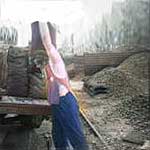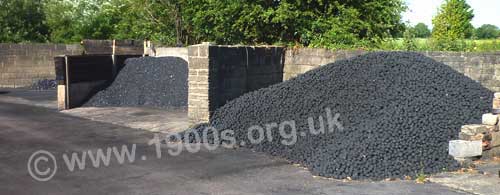The work of a coalman when coal was the nation's main fuel

A coalman was frequently seen on any British street when coal was the country's main fuel. Coalmen were delivering coal, but their work was so much more and extremely hard. This page is a glimpse into the past from the rare perspective of an actual coalman's personal experience.
____
By Terry Martinelli, former coalman, with firsthand contributions from others, edited by the webmaster
I spent many years working as a coalman, and this page is about my recollections of the work and life. The work was really hard, both physically and financially, but they were great times with loads and loads of laughs all the time. I'm glad I did the job and was sorry when I finished in the coal trade in 1967.
Loading the delivery lorry
The men on a delivery lorry - coalmen to you - were expected to load and deliver approximately 10 tons of coal a day in two loads. To get the right weight of coal into the sacks, we used a set of scales called an 'iron man' which was 5ft high and about 2ft wide and which had two hooks to hold the sacks while they were being filled.
The filled sacks were taken up a set of steps called a 'dole' to be placed on the lorry.
Small bags were put on top of the sacks; they were called 'riders' or 'pups', as they were half size.
The dole wasn't used in situations like when the photo was taken, because it was easier and quicker to shoulder the sacks onto the lorry as this particular load was a small - only about 3 tons. The lorry had to be loaded to both sides.
The work was seasonal. The following box gives a contribution from a fellow-coalman who describes the work in winter. Then I continue with what it was like in summer.
A day in the life of a coalman in winter
contributed by Albert Orr, former coalman
I started working for Charringtons Coal merchants in the late 1950s. It was really hard work and I was sore for many weeks until my body adapted.
My mate and I would arrive at the coal yard at about six in the morning - while it was still dark for much of the year. We would go to the office where we were given a ticket showing what our day's work was to be: essentially to load and deliver coal. Typically the load would be 2 tons of large coal, 2 tons of nuts, 1 ton of coalite and half to 1 ton of something else.
The procedure for bagging and loading was that my mate would place an empty bag on the scale. Then I would shovel from the appropriate heap into the bag. When the scale showed the full hundredweight, I would bend down, drag the corners of the bag and lift it on to my mates' back.
My mate would then run up into the delivery lorry and stack the bag at front of what we called the tray. Then he would come back down and grab another bag which I would fill. We would keep doing this until the lorry was loaded. All this was before breakfast.
Next came a welcome breakfast which was in the yard's cafe.
Having had breakfast, we would set out in the lorry to make the deliveries. This sometimes involved delivering inside houses, even upstairs, or down an alleyway round to the back of houses and into the garden to tip a sack into a coal bunker.
When we had delivered all the load, we would go back to the yard, load up another 5 to 6 tons, have something to eat and drink in the cafe, and then go out and deliver again.
In the busy winter period we would be loading and delivering 50 tons plus between us each day. Yes, we had to be tough in those days.
A coalman's work in the summer
In the summer, when coal deliveries were very low, we had to work in the yard unloading the deliveries to the yard into the bays. This was called 'landing' the coal or coke.

Load bays of coal in a coal yard
We often had to move the delivery trucks into position with 'pinch bars'. These were solid iron bars about 5ft long, 2inches thick and flat at one end. After taking off the brake of a truck, we would put a pinch bar under a wheel to lever it forward to the desired coal bay ready to be landed. Then we put the coal truck brake back on.
How a coalman’s work affected his health
contributed by Valerie Fife, whose father was a coalman
My father was riddled with chronic back problems caused by the constant lifting of the heavy sacks of coal. My mother would wash his back when he returned home from a day's work, and we children would pick out the tiny coal splinters which were embedded in his scalp! Two of us would work on his head at the same time!
There was no running hot water where we lived in Liverpool, so water from the cold tap was boiled on the stove. My mother always ensured that there would be a blazing fire to warm his change of clothes. His boots and jacket, though, had to be worn again for the next day's toil, and if they were wet she would dry them in front of the fire. The steaming hot coal dust was a typical smell.
The strenuous nature of the job took its toll on my father. The bitterly cold Lancashire winters gave him a bout of pneumonia and septicaemia in the mid 1960s, exacerbated by the on-going pressure sores on his back. Then the handling of the anthracite over the years caused chronic lymphatic leukaemia. He died age 64, just a few months after the diagnosis.
Anecdotes from delivering coal
- Often in freezing weather when there was a heavy frost, we had to light a small fire under our lorry engines to thaw them out, otherwise a core plug could be blown and cause a great loss of water and breakdown. This was around 1953, and I'm not sure if antifreeze was around then - and if it was, we were certainly not given any.
- Again in freezing weather, the heaps of fuels would often be one solid lump, so it was hard to get started shovelling them up into the sacks. One of the men was shovelling into the heap, trying to dig a cave-like hole into the heap when it suddenly caved in on him. The rest of us laughed our socks off! Luckily he wasn't hurt and joined in the laughter too.
- Coal lorries were often stopped by Weights and Measures to have their sacks and bags weighed to check they had the correct amount of fuel in them.
- We sometimes had to shoot the fuel down holes which went straight into cellars under the pavement. One day, it was my turn to go down into the cellar to trim the coal back as it was filling up. One time, when it was filling too quickly, I asked the lady of the house to ask my mate to stop shooting down to give me time to move some. She stood right over the hole to call to him to stop! Women did not wear trousers in those days. I've no need to tell you what I saw!
- Often a delivery had to be put in a small cupboard or coal hole under the stairs of a terrace house, which was awkward because the door was only 5ft high and 2ft wide. It was a tight struggle to get in and turn to shoot the coals under the lower part of the stairs. Sometimes after asking the customer to empty the cupboard to make it easier to get in, she would say she preferred to leave pots of paint and old tins on the shelves that the husband had built in there. All too often the lot went flying as we tried to turn inside! Needless to say, it was always OUR fault !!!
A coalman's pay and outgoings
Why a coalman’s job was financially difficult
contributed by Valerie Fife, whose father was a coalman
A coalman’s job was classified as unskilled which meant that my father’s wages were relatively low. Furthermore the job was seasonal because customers only needed coal for their fires during the winter months. So my father would be laid off during the summer with time on his hands but with very little income to support his large family.
The coal merchants I worked for
By way of background, the yard where I was working in the photo was in White Hart Lane, Tottenham. It was called Cades Coals, even though the lorry had Fry and Raxworthy on it and the actual owner of the lorry was Fred Fry who sold his business to Cades. The main merchants in the area were Charringtons at Palace Gates, Wood Green; Tyne Main at Finsbury Park; Fry and Raxworthy at Harringay (as it was then spelt) and Cades. I worked for Charringtons, Tyne Main, Fry and Raxworthy, and finally Cades where I spent seven years.
| sources | webmaster | contact |
Text and images are copyright
If you can add anything to this page or provide a photo, please contact me.



